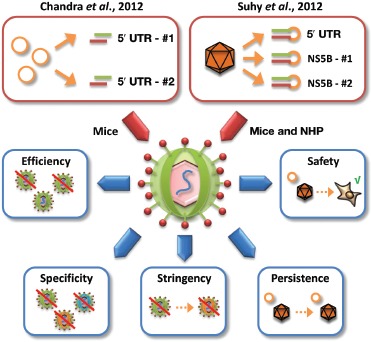Figure 1.

Two new coRNAi strategies against HCV. Represented at top are the two new coRNAi approaches reported in this issue, comprising either nanosome-mediated codelivery of two siRNAs against two regions within the HCV 5′ UTR (left box) or AAV8-mediated coexpression of three independent shRNAs against the HCV 5′ UTR or NS5B (two different target sites) (right box). The blue boxes show the critical parameters and aspects that must be considered in the context of coRNAi strategies and that were, accordingly, addressed in the two new HCV studies. They include (counterclockwise from left) the efficiency of target knockdown, the specificity against multiple naturally occurring viral variants, the stringency with which the coRNAi strategy can suppress resistant mutants, the persistence of the nonviral or viral vectors and hence the duration of target knockdown, and last, but not least, the safety of the vector–RNAi formulation in the liver and in potential off-target organs. 5′ UTR, 5′ untranslated region; coRNAi, combinatorial RNA interference; HCV, hepatitis C virus; NHP, nonhuman primate.
